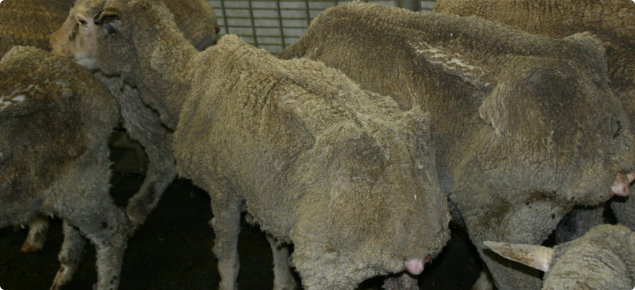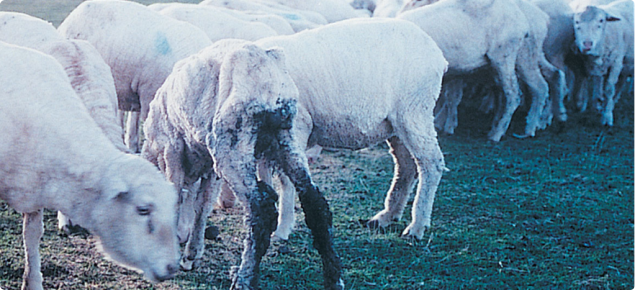Johne's disease (JD) must be reported
Under the Biosecurity and Agriculture Management Act 2007 (BAM Act), the detection of any strain of Johne’s disease (JD) in any species in WA must be reported, in order to support certification for live export markets. As a reportable disease, anyone with a suspicion or detection of JD in livestock must report it to a BAM Act authorised inspector, such as a DPIRD Field Veterinary Officer, as soon as possible. End box
Market implications of JD
Depending on the kind of livestock enterprise you run, the impact of a diagnosis of JD in sheep on your property will vary. Confirmation of any strain of JD has implications for your live export markets for cattle and sheep. A diagnosis of JD in sheep will also impact the biosecurity status of other susceptible livestock on your property, including cattle.
Live export
To access live export markets, the Federal Department of Agriculture, Water and the Environment (DAWE) and DPIRD must verify that both the individual animals being exported and the supplying property of origin meet the importing country’s requirements.
Requirements for JD vary between countries and producers should contact DAWE or see the Manual of Importing Country Requirements for specific market requirements. Market requirements change over time, so producers should confirm requirements with DAWE before preparing livestock.
The detection of any strain of JD would make the property ineligible for some live export markets for the timeframe defined in the importing country’s requirements. Detection of JD in either your cattle or sheep may mean you are ineligible for the defined timeframe to supply either or both species to markets with JD import requirements. Please contact DPIRD at livestockbiosecurity@dpird.wa.gov.au if you have any queries whether your property meets market-specific eligibility requirements.
Domestic market impact of JD
The economic impact of JD is far greater for studs and flocks that sell store or breeder sheep than for enterprises which sell mainly to slaughter. Potential buyers of sheep may not want to risk introducing JD to their flock.
Economic and production impacts
The impacts of JD in sheep vary from property to property. Some properties, particularly in the lower rainfall areas or the sheep/cropping zone, may experience little impact. Significant annual death rates may occur in other areas, especially in areas with higher rainfall, high stocking densities, or with permanent pastures. There may be no signs of the disease for the first few years following infection, but then death rates will increase over several years. In high spread areas, death rates of up to 15% per year can occur.
Severely affected flocks can show a decrease in wool cut and weaner weights. Vaccination and management procedures can help to minimise the impact of the disease on a farm.
Biosecurity planning to reduce the risk of JD
A biosecurity plan that helps reduce the risk of JD occurring in your flock will also help to manage the impacts of the disease if it occurs, and minimises the risk of other pests and diseases from occurring on your property.
For more information about general biosecurity planning visit www.farmbiosecurity.com.au or speak to your private vet.
Biosecurity precautions
A few simple precautions will significantly reduce the risk of JD entering your flock:
- Maintain a closed flock. Introducing infected sheep (or other susceptible livestock), which may be shedding bacteria despite showing no obvious signs of the disease, is the biggest risk of introducing JD to your flock.
If you do buy in livestock, follow good biosecurity practices, including:
- Buy in sheep that are approved vaccinates. Vaccination alone does not eliminate the risk of JD but it significantly reduces it.
- Vaccination is generally recommended if:
- the business risk of JD is high — for example, sellers of breeding or replacement sheep
- the likelihood of infection being introduced is high — for example, if you are in a high-prevalence area or have an infected neighbour.
- Only buy from properties with a health status as good as, or better than, your own. Follow the same rules if bringing in agistment stock.
- Ask for a National Sheep Health Declaration. This requires the vendor to disclose the JD status of their flock. Be aware that the sheep health declaration can only describe what the vendor knows so you may wish to ask for additional testing.
- Only transport purchased sheep in clean vehicles. Discuss vehicle cleaning protocols with your transporter.
- Maintain National Livestock Identification System (NLIS) database records of movements on and off your property to ensure whole-of-life traceability.
- Maintain fences to prevent sheep straying on and off your property. Work together with neighbours to reduce the risk of straying.
- Check regularly for strays in your flock. Promptly remove and isolate strays.
- Assess your risk and consider vaccination. In areas with high JD prevalence, vaccination is one of the best ways to manage your risk.
- Restrict visitor and vehicle movement onto your property to designated driveways and access roads.
- Use semen and embryos for introducing new genetics; this reduces the risk of introducing disease.
- Check the health protocols for shows and breeding centres and isolate sheep as much as possible.
- Inspect your sheep regularly and report any unusual signs to your veterinarian.
Health status declarations
Before buying livestock, assess the JD risk of a property, including looking at:
- Vaccination status — vaccination alone does not completely eliminate the risk of JD in sheep but it significantly reduces the risk of bringing JD onto your property in purchased sheep.
- Current JD status — are the livestock on the property known or suspected to be infected? Have the livestock on the property been tested, and if so, when and what was the result?
- Trading history — is it a closed property/flock/herd? If not, does it buy livestock from multiple sources? What is the status of the flock of origin for introduced livestock?
- Is the property in the sheep market assurance program (SheepMAP)? The higher the SheepMAP status, the higher the level of assurance JD is not present. If the source property has other JD-susceptible livestock, are they in the relevant industry assurance programs for those livestock e.g. Johne’s Beef Assurance Score and Johne’s Dairy Disease Score?
Much of this information is included in the national animal health declarations. Always request a completed animal health declaration when buying livestock.
JD sheep market assurance program (SheepMAP)
SheepMAP is the Australian JD market assurance program for sheep. It is a voluntary national program to identify and help protect flocks at low risk of being infected with JD. Producers can search for a MAP-accredited flock on Animal Health Australia’s (AHA’s) website.
Having a SheepMAP status does not guarantee a flock does not have JD, but the higher the status of a flock, the greater the probability it is not infected.
Most flocks in the SheepMAP are stud flocks and can provide a source of low-risk rams for commercial producers.
SheepMAP accreditation involves the producer and a SheepMAP accredited veterinarian of the producer’s choice carrying out an assessment of the flock’s history, management and biosecurity arrangements.
This is followed by a flock faecal test of 350 representative adult sheep under veterinary supervision. For flocks with fewer than 350 adults, all sheep over the age of two years are tested. This test gives a high level of confidence that if JD was present in the flock, it would be detected. A negative test result means the flock can enter the program as Monitored Negative 1(MN1). Flocks in the SheepMAP can progress to MN2 and MN3 by carrying out further flock tests at intervals of at least two years. Each successive negative test provides more assurance.
Producers with SheepMAP flocks can vaccinate for JD with a registered vaccine. Vaccination can be used to maintain, but not progress, status in the SheepMAP. See the vaccination section for more details.
For more information about SheepMAP, see the AHA MAP webpage.


